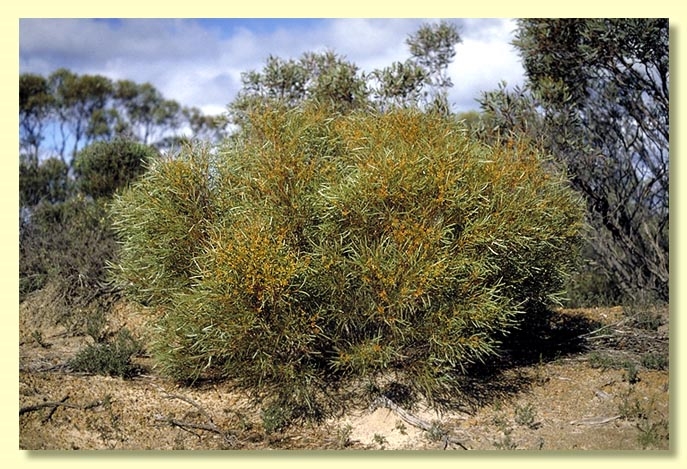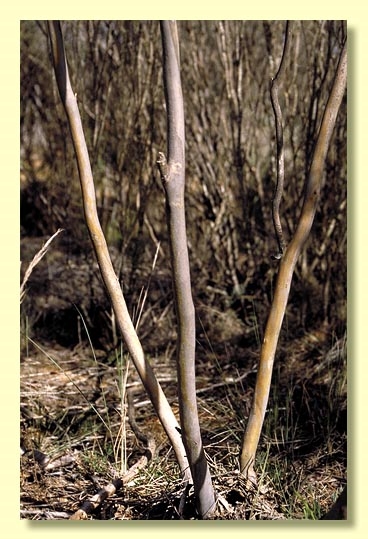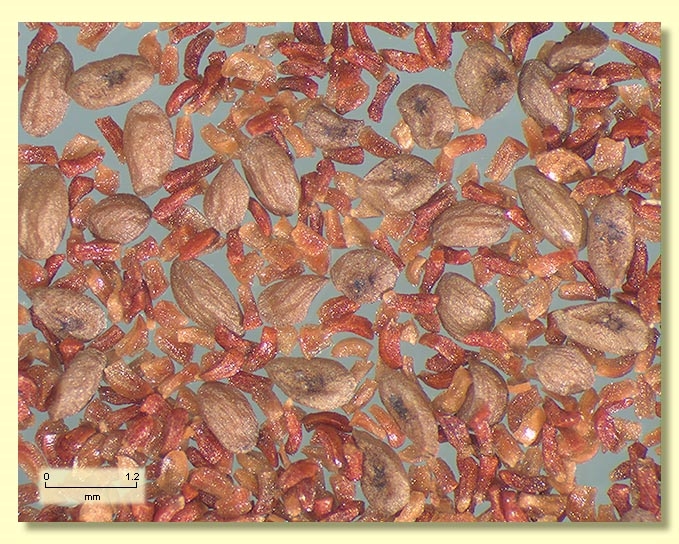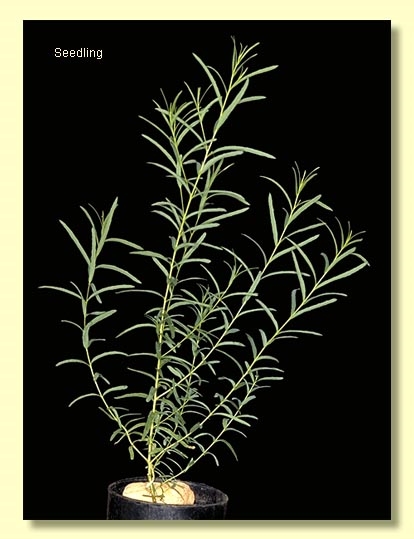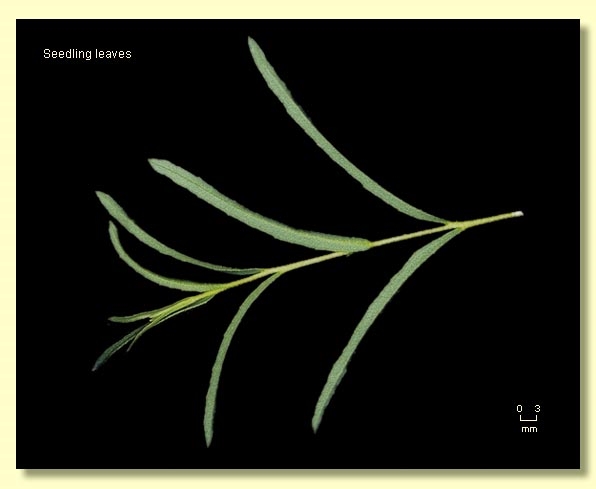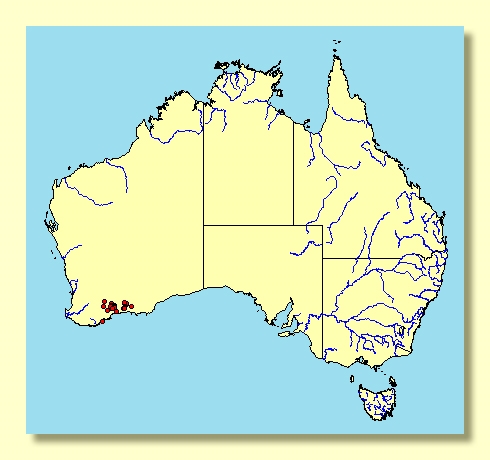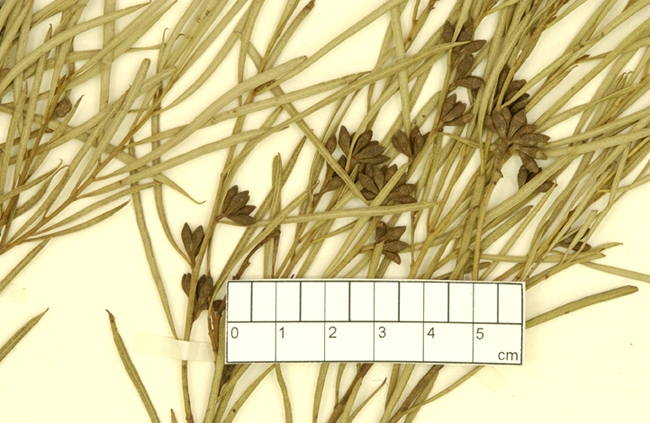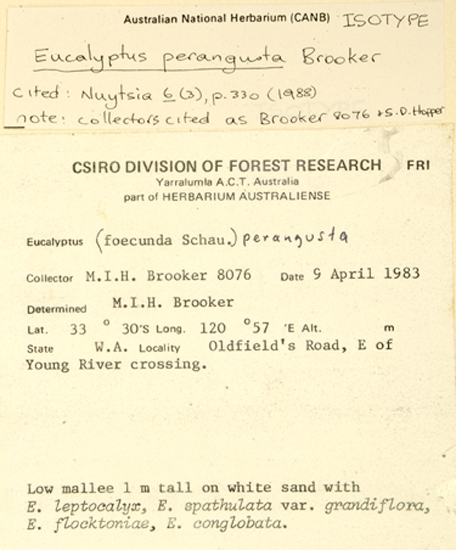Euclid - Online edition
Eucalyptus perangusta
Eucalyptus | Symphyomyrtus | Bisectae | Destitutae | Porantherae | Longiores
Bark smooth throughout, pale grey and tan, shedding in thin curly flakes.
Branchlets lacking oil glands in the pith.
Juvenile growth (coppice or field seedlings to 50 cm): stems rounded in cross-section, smooth or slightly warty; juvenile leaves sessile to sub-sessile, opposite at lowest nodes only, soon alternate, oblong-linear, 1–3.5 cm long, 0.1–0.3 cm wide, dull, grey-green to green.
Adult leaves alternate, petiole 0.2–1 cm long; blade linear, (3.3)4–8 cm long, 0.2–0.5 cm wide, base tapering to petiole, margin entire, apex finely pointed, concolorous, green, glossy, venation generally obscure except midrib, any side-veins visible are about perpendicular to midrib, intersectional oil glands irregularly-shaped and occur on visible fragments of reticulation, intramarginal vein present or obscure.
Inflorescence axillary unbranched, peduncles angular to slightly flattened, 0.2–1 cm long, buds 7 or 9, pedicellate, pedicels 0.1–0.4 cm long. Mature buds ovoid to almost fusiform (0.5–0.9 cm long, 0.2–0.3 cm wide), scar present, operculum conical or slightly beaked (0.25–0.4 cm long), hypanthium sometimes with ribs continuing from the angled pedicel, stamens inflexed, anthers cuneate-cuboid to globoid, adnate to filament apex (rigidly basifixed), dehiscing by sub-terminal pores, a few of the innermost stamens imperfectly formed, style long and straight, stigma tapered or blunt, locules 3(4), the placentae each with 4 vertical rows of ovules. Flowers creamy white.
Fruit pedicellate, pedicels 0.1–0.3 cm long, very shortly barrel-shaped to truncate globose, 0.4–0.6 cm long, 0.4–0.5(0.6) cm wide, disc pale, usually descending, valves 3(4), held about rim level.
Seeds brown, 0.8–1.5 mm long, flattened-ovoid, dorsal surface furrowed or not, scarcely reticulate, hilum ventral.
Cultivated seedlings (measured at node 10): cotyledons Y-shaped (bisected); stems rounded in cross-section, warty or smooth; leaves sessile, opposite for 11–22 nodes then alternate, linear-oblong becoming linear further up stem, 1.5–6.5 cm long, 0.1–0.5(0.7) cm wide, green to grey-green, scarcely discolorous to concolorous, dull.
Flowering has been recorded in December.
A slender-stemmed, smooth-barked and fine-leaved mallee endemic to Western Australia growing in sandplain heath in the area from Ravensthorpe and Newdegate to Salmon Gums.
Eucalyptus perangusta belongs in Eucalyptus subgenus Symphyomyrtus section Bisectae subsection Destitutae because the buds have two opercula, cotyledons are Y-shaped and branchlets lack oil glands in the pith. Within this subsection E. perangusta is one of a group of about 16 species, series Porantherae, that are further characterised by having anthers completely adnate to the staminal filaments, strongly inflexed stamens, densely reticulate leaves with intersectional oil glands and by the fruit with a distinct thick rim that includes a whitish descending disc. The small, glossy leaves of species in series Porantherae may result in confusion with species in series Heterostemones; however, the fruit alone usually distinguish the series. The fruit of series Heterostemones are thin-rimmed.
E. perangusta has some of the narrowest leaves (less than 0.5 cm wide) of all eucalypt species in its area of occurrence making the crown very distinctive. The only species in this area with similarly narrow leaves is E. angustissima, a mallee of white sands near salt lakes and drainage lines in the Speddingup area. It is distinguished from E. perangusta by its short ovoid buds and flattened swollen fruit.
The only species in series Porantherae having equally narrow leaves is E. formanii. It is a Western Australian endemic found only in the arid Die Hardy Range area north of Southern Cross and Bullfinch and is usually a tree, has rough bark and produces characteristic dense clusters of linear-leaved, glaucous coppice growth.

